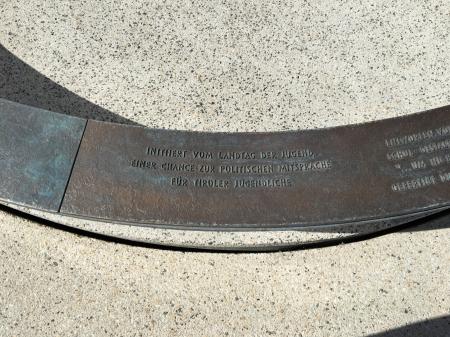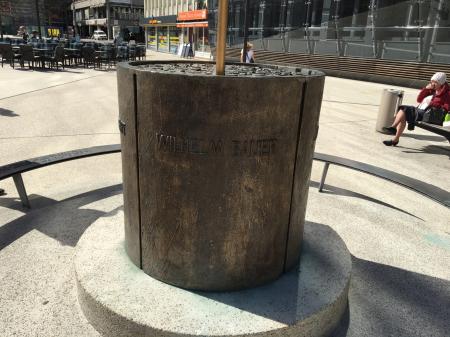Obj. ID: 30937
Memorials Pogrom Monument in Innsbruck, Austria, 1997

Memorial Name
Pogromdenkmal [Pogrom Monument]
Who is Commemorated?
Victims of the November Pogrom of 1938 in Innsbruck.
Description:
The monument is situated at the Eduard-Wallnöfer-Platz, in front of the New Landhaus, the Liberation Monument erected in 1948, and the new Unification Fountain.
The monument consists of a solid copper round base and a seven-meter-high menorah. The names of four Jews murdered during the program are inscribed on the sides of the base and its upper edge is covered by shards of glass. A metal circle band with German inscriptions surrounds the monument.
Inscription:
On the copper base, the names of four people murdered during the November Pogrom:
Josef Adler
Wilhelm Bauer
Richard Berger
Richard Graubart
On the metal circle band that surrounds the monument:
… um nicht zu verschweigen,
dass in der Nacht vom 9. Zum 10. November 1938, „Reichskristallnacht“ – Novemberpogrom,
jüdische Mitbürger in Innsbruck ermordet wurden
und ihnen viele Kinder, Frauen und Männer in den Tod folgen mussten …
… um nicht zu vergessen,
dass Vorurteile, Hass und Unbesonnenheit
zu einer Grausamen spirale der Gewalt führen können …
… wurde dieses Mahnmal 1997 errichtet.
Translation: ...not to conceal the fact that in the night from November 9 to 10, 1938, Reichskristallnacht-November pogrom, Jewish fellow citizens were murdered in Innsbruck and many children, women, and men had to follow them to their deaths...
... not to forget that prejudice, hatred, and recklessness can lead to a cruel spiral of violence...
...this memorial was erected in 1997.
Initiiert vom Landtag der Jugend,
einer Chance zur politischen Mitsprache
für Tiroler Jugendliche
Entworfen von Mario Jörg,
Schul-Gestaltungswettbewerb
„… um nicht zu vergessen“
Gefertigt durch die HTL Fulpmes
Translation: Initiated by the Landtag der Jugend [the Parliament of the Youth], an opportunity for Tyrolean young people to have a say in politics. Designed by Mario Jörg, school design competition "… not to forget." Manufactured by HTL [=Höhere Technische Lehranstalt] Higher Technical College] in Fulpmes.
Commissioned by
Landtag der Jugend [the Parliament of the Youth]
sub-set tree:
According to the text by Tanja Gschnell and Horst Schreiber at the website Eduard-Wallnöfer-Platz (https://www.eduard-wallnoefer-platz.at/pogromdenkmal/das-pogromdenkmal.php):
"On November 17, 1995, young people in the “Parliament of Youth” proposed building a memorial in the old town of Innsbruck for the Jews murdered in the pogrom night in November 1938. The members of this project group were Herwig Ostermann, Walter Fuchs, Daniel Knabl, Mirjam Dauber, and Sibylle Hammer. This proposal was accepted in December 1995 by Mayor Herwig van Staa, who could imagine such a monument on Landhausplatz in Innsbruck. State Councilor Dr. Elisabeth Zanon took over the execution and wrote out a project under the motto “…not to forget”.
The project stipulated that Tyrol's secondary schools should develop proposals for such a monument and submit them within a few months. There was less than half a year between the announcement of the project and the submission deadline. Monuments that are intended to commemorate the persecution of the Jews and the Holocaust represent a huge challenge from an aesthetic point of view, which are otherwise tackled by well-known architects and artists around the world and always provoke long-lasting public discussions.
In the summer of 1996, an expert jury evaluated the 48 submitted works and chose the idea of the then 19-year-old student Mario Jörg, who attended the Higher Technical College for Mechanical Engineering in Fulpmes.
He developed the plan for a monument that consisted of a seven-branched menorah, on whose copper base shards of glass with the names of the four Jews killed in the night of the pogrom or in its wake in Innsbruck in November 1938 were mounted. According to Jörg, the shards of glass were intended to symbolize the broken hearts of the murdered Jews and their relatives.
On Sunday, June 8, 1997, the pogrom memorial on Landhausplatz (now Eduard-Wallnöfer-Platz) in Innsbruck was opened to the public. Instead of a traditional inauguration, the Chief Rabbi of the Austrian Religious Community Paul Chaim Eisenberg said prayers in Hebrew and German, in which he remembered the victims of the pogrom night and expressed his joy at the inauguration. The Innsbruck diocesan bishop Reinhold Stecher compared the memorial to a sundial that casts its shadows on people's conscience. Yoel Sher, the Israeli ambassador, emphasized the sacred duty of remembrance towards the victims of the Holocaust.
Also present were the President of the Jewish Community of Austria, Paul Grosz, and the President of the Jewish Community of Tyrol-Vorarlberg, Esther Fritsch. They praised the enthusiasm, drive, and persistence of the Tyrolean youth. The celebration was given a special touch by the fact that the state of Tyrol invited Jewish expellees and Holocaust survivors and their relatives. The well-known Austrian jazz musician Oscar Klein, whose mother comes from a Jewish family in Innsbruck, provided music for the celebration." (https://www.eduard-wallnoefer-platz.at/pogromdenkmal/das-pogromdenkmal.php)
As part of the redesign of the Landhausplatz, the memorial was moved slightly and repositioned in January 2011. Since March 2012 a website on the Eduard-Wallnöfer-Platz has provided detailed descriptions of the monuments on this square.
According to the "Reactions" chapter of the aforementioned text,
"Historians particularly criticized the narrowing of the memory to the four victims of the November pogrom, as at that time an ongoing research project at the University of Innsbruck had already identified over 160 Jewish Nazi victims from Tyrol. The creation of an accompanying scientific brochure for schools was rejected by politicians, and the Israelite Community was only involved in the planning of the project afterwards.
The controversies that arose when such monuments were erected in Vienna and Berlin, for example, were completely absent in Innsbruck. “Der Standard” suspected that the cause was the fact that the initiative had grown out of the commitment of young people who had tried to come to terms with the pogrom in their own way. In addition, the simple yet clear symbolism of the monument was well received by the public. An article by the editor-in-chief of the “Kronen Zeitung” that had a clearly anti-Semitic tone should be highlighted negatively. Walther Prüller saw no need to make such a public memorial. On the one hand, he criticized the construction costs for what he described as a “monster of remembrance”, at the inauguration of which “500 followers of the Mosaic faith” were expected. On the other hand, in the tradition of Austrian defense of guilt, he asked: “Where is there actually a monument in Innsbruck to the hundreds of citizens who died in bombing raids?”" (https://www.eduard-wallnoefer-platz.at/pogromdenkmal/das-pogromdenkmal.php). For additional reactions, see https://www.eduard-wallnoefer-platz.at/pogromdenkmal/reaktionen-zum-pogromdenkmal.php.
Gschnell, Tanja, and Horst Schreiber, "Das Pogromdenkmal," Der Eduard-Wallnöfer-Platz in Innsbruck, https://www.eduard-wallnoefer-platz.at/pogromdenkmal/das-pogromdenkmal.php (accessed April 30, 2024)












